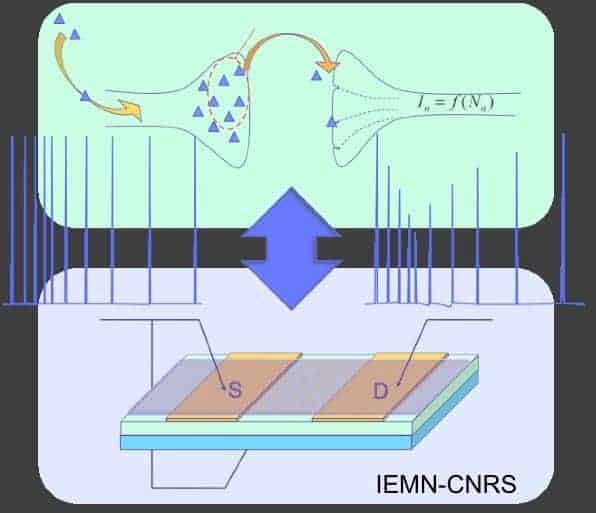
Researchers in France claim to have made the first transistor that mimics connections in the human brain. The device, which is based on pentacene and gold nanoparticles, could lead to a new generation of neuro-inspired computers as well as help connect artificial structures to biological tissue.
Dominique Vuillaume of the University of Lille and colleagues studied how electric charges flow through the device and discovered that they behave in the same way as chemical neurotransmitters moving through a synaptic connection in the brain. “This is the first time that an electronic device has been shown to mimic a biological synapse,” Vuillaume told physicsworld.com.
The team, which includes scientists from the CNRS (the French National Science Agency) and CEA (the French Atomic Energy Commission), began by adding gold nanoparticles to the interface between an insulating layer (gate dielectric) and an organic transistor made of pentacene. They fixed the nanoparticles, which were 5, 10 and 20 nm in diameter, into the source-drain channel of the device using surface chemistry techniques and finished the structure by covering it with a 35 nm thick film of pentacene. The resulting device is called a nanoparticle organic memory field-effect transistor or “NOMFET”.
Short-term plasticity
A biological synapse transforms a voltage spike (action potential) arriving from a pre-synaptic neuron into a discharge of chemical neurotransmitters that are then detected by a post-synaptic neuron. These are subsequently transformed into new spikes, leading to a succession of pulses that either become larger or diminish in size. This fundamental property of synaptic behaviour is known as short-term plasticity, which is related to a neural network’s ability to learn. It is this plasticity that Vuillaume and colleagues have succeeded in mimicking.
In the NOMFET, the pre-synaptic signal is simply the pulse voltage applied to the device and the output signal is the drain current, explains Vuillaume. The holes – the charge carriers in the p-type organic semiconductor employed – are trapped in the nanoparticles and act like the neurotransmitters. A certain number of holes are trapped for each incoming spike voltage and in the absence of pulses, the holes escape in a matter of seconds
This time delay is carefully adjusted by the researchers by optimizing nanoparticle number and device geometry. “The output of the NOMFET is thus able to reproduce the deceasing or amplifying behaviour typical of a synapse depending on the frequency of spikes,” said Vuillaume.
Neuro-inspiration
The technique could be used build nanoscale devices for neuro-inspired computers, he added. “The human brain contains more synapses than neurons by a factor of 104 so we need to develop nanoscale, low-power, synapse-like devices if we want to scale neuromorphic circuits to the brain level.”
Although neural networks based on silicon chips have already been developed and used in certain applications, such approaches are limited because it takes at least seven transistors to build one electronic synapse. In this latest work, the same job is done with just a single NOMFET device.
The devices could also be used to increase the performance of neural-network computing circuits. And because the nanomaterials employed work on flexible, plastic substrates, they might be used to connect artificial neuromorphic circuits based on the NOMFET to “soft” biological tissue, speculates Vuillaume.
The work was reported in Advanced Functional Materials.



